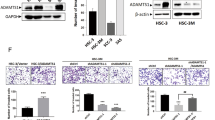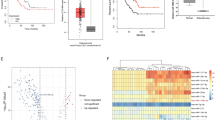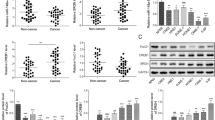Abstract
Connective tissue growth factor (CTGF) is a multi-functional secreted protein, and it has been shown either to promote or suppress tumor progression among different kinds of cancers. Here, we investigated the role of CTGF in oral squamous cell carcinoma (OSCC) invasion and metastasis. In five OSCC cell lines, endogenous CTGF negatively correlated with invasiveness. Exogenous CTGF protein or forced expression of CTGF gene in the oral cancer cell line SAS significantly decreased their invasive and migratory abilities. MicroRNA (miRNA) microarray analysis was performed in CTGF-overexpressed SAS cells (SAS/CTGF-M3) versus control cells to investigate the mechanism of CTGF-mediated inhibition of OSCC invasion. Among the miRNAs regulated by CTGF, miR-504 and miR-346 were the top two miRNAs downregulated in CTGF transfectants, and the result was confirmed by quantitative reverse transcriptase–PCR. Ectopic miR-504 increased migration and invasion in SAS/CTGF-M3, however, miR-346 did not have such impact on migration/invasion. Furthermore, we identified FOXP1, a member of forkhead transcription factors, as a target gene that takes part in the miR-504-induced cellular invasion. Knockdown of FOXP1 increased invasiveness in SAS/CTGF-M3, confirming the signal axis of CTGF/miR-504/FOXP1 in OSCC. Animal experiments showed that SAS/CTGF-M3-formed orthotopic tumors were associated with a lesser invasive phenotype than control cells. Expression of miR-504 in SAS/CTGF-M3 increased lymph node metastasis, and co-expression of FOXP1 in miR-504-transfected SAS/CTGF-M3 alleviated miR-504-induced metastasis. In OSCC samples, high CTGF was associated with a lower clinical stage and a better outcome. A reverse correlation between CTGF and miR-504, miR-504 and FOXP1, and a positive correlation between CTGF and FOXP1 were shown. Our study discovers a novel signal pathway involving the regulation of miRNA machinery by a secreted cytokine, which will be beneficial for developing therapeutic strategy against advanced OSCC.
This is a preview of subscription content, access via your institution
Access options
Subscribe to this journal
Receive 50 print issues and online access
$259.00 per year
only $5.18 per issue
Buy this article
- Purchase on Springer Link
- Instant access to full article PDF
Prices may be subject to local taxes which are calculated during checkout







Similar content being viewed by others
Accession codes
References
Abreu JG, Ketpura NI, Reversade B, De Robertis EM . (2002). Connective-tissue growth factor (CTGF) modulates cell signalling by BMP and TGF-beta. Nat Cell Biol 4: 599–604.
Banham AH, Beasley N, Campo E . (2001). The FOXP1 winged helix transcription factor is a novel candidate tumor suppressor gene on chromosome 3p. Cancer Res 61: 8820–8829.
Brigstock DR . (1999). The connective tissue growth factor/cysteine-rich 61/nephroblastoma overexpressed (CCN) family. Endocr Rev 20: 189–206.
Carlsson P, Mahlapuu M . (2002). Forkhead transcription factors: key players in development and metabolism. Dev Biol 250: 1–23.
Chan CS, Elemento O, Tavazoie S . (2005). Revealing posttranscriptional regulatory elements through network-level conservation. PLoS Comput Biol 1: e69.
Chang CC, Shih JY, Jeng YM, Su JL, Lin BR, Chen ST et al. (2004). Connective tissue growth factor and its role in lung adenocarcinoma invasion and metastasis. J Natl Cancer Inst 96: 364–375.
Chen PS, Wang MY, Wu SN, Su JL, Hong CC, Chuang SE et al. (2007). CTGF enhances the motility of breast cancer cells via an integrin-αvβ3–ERK1/2-dependent S100A4-upregulated pathway. J Cell Sci 120: 2053–2065.
Chu CY, Chang CC, Prakash E, Kuo ML . (2008). Connective tissue growth factor (CTGF) and cancer progression. J Biomed Sci 15: 675–685.
Chu YW, Yang PC, Yang SC, Shyu YC, Hendrix MJ, Wu R et al. (1997). Selection of invasive and metastatic subpopulations from a human lung adenocarcinoma cell line. Am J Respir Cell Mol Biol 17: 353–360.
Chuang JY, Yang WY, Lai CH, Lin CD, Tsai MH, Tang CH . (2011). CTGF inhibits cell motility and COX-2 expression in oral cancer cells. Int Immunopharmacol 11: 948–954.
Haddad RI, Shin DM . (2008). Recent advances in head and neck cancer. N Engl J Med 359: 1143–1154.
Hashimoto Y, Shindo-Okada N, Tani M, Nagamachi Y, Takeuchi K, Shiroishi T et al. (1998). Expression of the Elm1 gene, a novel gene of the CCN (connective tissue growth factor, Cyr61/Cef10, and neuroblastoma overexpressed gene) family, suppresses in vivo tumor growth and metastasis of K-1735 murine melanoma cells. J Exp Med 187: 289–296.
Hu W, Chan CS, Wu R, Zhang C, Sun Y, Song JS et al. (2010). Negative regulation of tumor suppressor p53 by microRNA miR-504. Mol Cell 38: 689–699.
Huebner K . (2001). Tumor suppressors on 3p: a neoclassic quartet. Proc Natl Acad Sci USA 98: 14763–14765.
Jerjes W, Upile T, Petrie A, Riskalla A, Hamdoon Z, Vourvachis M et al. (2010). Clinicopathological parameters, recurrence, locoregional and distant metastasis in 115 T1-T2 oral squamous cell carcinoma patients. Head Neck Oncol 20: 2–9.
Joliot V, Martinerie C, Dambrine G, Plassiart G, Brisac M, Crochet J et al. (1992). Proviral rearrangements and overexpression of a new cellular gene (nov) in myeloblastosis-associated virus type 1-induced nephroblastomas. Mol Cell Biol 12: 10–21.
Kademani D . (2007). Oral cancer. Mayo Clin Proc 82: 878–887.
Kang Y, Siegel PM, Shu W, Drobnjak M, Kakonen SM, Cordón-Cardo C et al. (2003). A multigenic program mediating breast cancer metastasis to bone. Cancer Cell 3: 537–549.
Katoh M . (2004). Human FOX gene family (review). Int J Oncol 25: 1495–1500.
Koliopanos A, Friess H, di Mola FF, Tang WH, Kubulus D, Brigstock D et al. (2002). Connective tissue growth factor gene expression alters tumor progression in esophageal cancer. World J Surg 26: 420–427.
Kumar MS, Lu J, Mercer KL, Golub TR, Jacks T . (2007). Impaired microRNA processing enhances cellular transformation and tumorigenesis. Nat Genet 39: 673–677.
Lau LF, Lam SC . (1999). The CCN family of angiogenic regulators: the integrin connection. Exp Cell Res 248: 44–57.
Lim LP, Lau NC, Garrett-Engele P, Grimson A, Schelter JM, Castle J et al. (2005). Microarray analysis shows that some microRNAs downregulate large numbers of target mRNAs. Nature 433: 769–773.
Lin BR, Chang CC, Che TF, Chen ST, Chen RJ, Yang CY et al. (2005). Connective tissue growth factor inhibits metastasis and acts as an independent prognostic marker in colorectal cancer. Gastroenterology 128: 9–23.
Ma L, Teruya-Feldstein J, Weinberg RA . (2007). Tumour invasion and metastasis initiated by microRNA-10b in breast cancer. Nature 449: 682–688.
Moritani NH, Kubota S, Nishida T, Kawaki H, Kondo S, Sugahara T et al. (2003). Suppressive effect of overexpressed connective tissue growth factor on tumor cell growth in a human oral squamous cell carcinoma-derived cell line. Cancer Lett 192: 205–214.
O'Brien TP, Yang GP, Sanders L, Lau LF . (1990). Expression of cyr61, a growth factor-inducible immediate-early gene. Mol Cell Biol 10: 3569–3577.
Pan LH, Beppu T, Kurose A, Yamauchi K, Sugawara A, Suzuki M et al. (2002). Neoplastic cells and proliferating endothelial cells express connective tissue growth factor (CTGF) in glioblastoma. Neurol Res 24: 677–683.
Perbal B . (2001). The CCN family of genes: a brief history. Mol Pathol 54: 103–104.
Planque N, Perbal B . (2003). A structural approach to the role of CCN (CYR61/CTGF/NOV) proteins in tumourigenesis. Cancer Cell Int 3: 15.
Saito Y, Liang G, Egger G, Friedman JM, Chuang JC, Coetzee GA et al. (2006). Specific activation of microRNA-127 with downregulation of the proto-oncogene BCL6 by chromatin-modifying drugs in human cancer cells. Cancer Cell 9: 435–443.
Scott GK, Mattie MD, Berger CE, Benz SC, Benz CC . (2006). Rapid alteration of microRNA levels by histone deacetylase inhibition. Cancer Res 66: 1277–1281.
Shimo T, Kubota S, Goda T, Yoshihama Y, Kurio N, Nishida T et al. (2008). Clinical significance and pathogenic function of connective tissue growth factor (CTGF/CCN2) in osteolytic mandibular squamous cell carcinoma. Anticancer Res 28: 2343–2348.
Soon LL, Yie TA, Shvarts A, Levine AJ, Su F, Tchou-Wong KM . (2003). Overexpression of WISP-1 down-regulated motility and invasion of lung cancer cells through inhibition of Rac activation. J Biol Chem 278: 11465–11470.
Tong X, Xie D, O'Kelly J, Miller CW, Muller-Tidow C, Koeffler HP . (2001). Cyr61, a member of CCN family, is a tumor suppressor in non-small cell lung cancer. J Biol Chem 276: 47709–47714.
Voorhoeve PM, le Sage C, Schrier M, Gillis AJ, Stoop H, Nagel R et al. (2006). A genetic screen implicates miRNA-372 and miRNA-373 as oncogenes in testicular germ cell tumors. Cell 124: 1169–1181.
Vokes EE, Weichselbaum RR, Lippman SM, Hong WK . (1993). Head and neck cancer. N Engl J Med 328: 184–194.
Wutzl A, Ploder O, Kermer C, Millesi W, Ewers R, Klug C . (2007). Mortality and causes of death after multimodality treatment for advanced oral and oropharyngeal cancer. J Oral Maxillofac Surg 65: 255–260.
Xue ZH, Zhao CQ, Chua GL, Tan SW, Tang XY, Wong SC et al. (2010). Integrin alphaMbeta2 clustering triggers phosphorylation and activation of protein kinase C delta that regulates transcription factor Foxp1 expression in monocytes. J Immunol 184: 3697–3709.
Yosimichi G, Nakanishi T, Nishida T, Hattori T, Takano-Yamamoto T, Takigawa M . (2001). CTGF/Hcs24 induces chondrocyte differentiation through a p38 mitogen-activated protein kinase (p38MAPK), and proliferation through a p44/42 MAPK/extracellular-signal regulated kinase (ERK). Eur J Biochem 268: 6058–6065.
Zabarovsky ER, Lerman MI, Minna JD . (2002). Tumor suppressor genes on chromosome 3p involved in the pathogenesis of lung and other cancers. Oncogene 21: 6915–6935.
Acknowledgements
This work was supported by grants from National Science Council, Taiwan NSC-97-2314-B-002-031-MY2, NSC-98-2320-B-002-003 (to CCC) and NSC-99-2314-B-010-007-MY3 (to MHY).
Author information
Authors and Affiliations
Corresponding author
Ethics declarations
Competing interests
The authors declare no conflict of interest.
Additional information
Supplementary Information accompanies the paper on the Oncogene website
Supplementary information
Rights and permissions
About this article
Cite this article
Yang, MH., Lin, BR., Chang, CH. et al. Connective tissue growth factor modulates oral squamous cell carcinoma invasion by activating a miR-504/FOXP1 signalling. Oncogene 31, 2401–2411 (2012). https://doi.org/10.1038/onc.2011.423
Received:
Revised:
Accepted:
Published:
Issue Date:
DOI: https://doi.org/10.1038/onc.2011.423
Keywords
This article is cited by
-
Sulforaphane as a Promising Natural Molecule for Cancer Prevention and Treatment
Current Medical Science (2021)
-
The Role of Increased Connective Tissue Growth Factor in the Pathogenesis of Oral Submucous Fibrosis and its Malignant Transformation—An Immunohistochemical Study
Head and Neck Pathology (2021)
-
Zinc Gluconate Induces Potentially Cancer Chemopreventive Activity in Barrett’s Esophagus: A Phase 1 Pilot Study
Digestive Diseases and Sciences (2021)
-
Comprehensive profiling of extracellular RNA in HPV-induced cancers using an improved pipeline for small RNA-seq analysis
Scientific Reports (2020)
-
miR-504 modulates the stemness and mesenchymal transition of glioma stem cells and their interaction with microglia via delivery by extracellular vesicles
Cell Death & Disease (2020)



